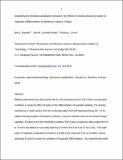Straddling the tholeiitic/calc-alkaline transition: the effects of modest amounts of water on magmatic differentiation at Newberry Volcano, Oregon
Author(s)
Mandler, Ben; Donnelly-Nolan, Julie M.; Grove, Timothy L.
Download410_2014_1066_ReferencePDF.pdf (2.060Mb)
OPEN_ACCESS_POLICY
Open Access Policy
Creative Commons Attribution-Noncommercial-Share Alike
Terms of use
Metadata
Show full item recordAbstract
Melting experiments have been performed at 1 bar (anhydrous) and 1- and 2-kbar H2O-saturated conditions to study the effect of water on the differentiation of a basaltic andesite. The starting material was a mafic pumice from the compositionally zoned tuff deposited during the ~75 ka caldera-forming eruption of Newberry Volcano, a rear-arc volcanic center in the central Oregon Cascades. Pumices in the tuff of Newberry caldera (TNC) span a continuous silica range from 53 to 74 wt% and feature an unusually high-Na2O content of 6.5 wt% at 67 wt% SiO2. This wide range of magmatic compositions erupted in a single event makes the TNC an excellent natural laboratory in which to study the conditions of magmatic differentiation. Our experimental results and mineral–melt hygrometers/thermometers yield similar estimates of pre-eruptive H2O contents and temperatures of the TNC liquids. The most primitive (mafic) basaltic andesites record a pre-eruptive H2O content of 1.5 wt% and a liquidus temperature of 1,060–1,070 °C at upper crustal pressure. This modest H2O content produces a distinctive fractionation trend that is much more enriched in Na, Fe, and Ti than the calc-alkaline trend typical of wetter arc magmas, but slightly less enriched in Fe and Ti than the tholeiitic trend of dry magmas. Modest H2O contents might be expected at Newberry Volcano given its location in the Cascade rear arc, and the same fractionation trend is also observed in the rim andesites of the rear-arc Medicine Lake volcano in the southern Cascades. However, the Na–Fe–Ti enrichment characteristic of modest H2O (1–2 wt%) is also observed to the west of Newberry in magmas erupted from the arc axis, such as the Shevlin Park Tuff and several lava flows from the Three Sisters. This shows that modest-H2O magmas are being generated directly beneath the arc axis as well as in the rear arc. Because liquid lines of descent are particularly sensitive to water content in the range of 0–3 wt% H2O, they provide a quantitative and reliable tool for precisely determining pre-eruptive H2O content using major-element data from pumices or lava flows. Coupled enrichment in Na, Fe, and Ti relative to the calc-alkaline trend is a general feature of fractional crystallization in the presence of modest amounts of H2O, which may be used to look for “damp” fractionation sequences elsewhere.
Date issued
2014-10Department
Massachusetts Institute of Technology. Department of Earth, Atmospheric, and Planetary SciencesJournal
Contributions to Mineralogy and Petrology
Publisher
Springer Berlin Heidelberg
Citation
Mandler, Ben E., Julie M. Donnelly‑Nolan, and Timothy L. Grove. "Straddling the tholeiitic/calc‑alkaline transition: the effects of modest amounts of water on magmatic differentiation at Newberry Volcano, Oregon." Contributions to Mineralogy and Petrology. 2014 Oct 01;168(4):1066.
Version: Author's final manuscript
ISSN
0010-7999
1432-0967